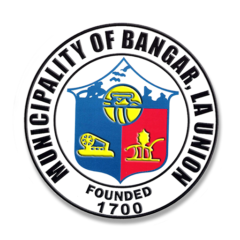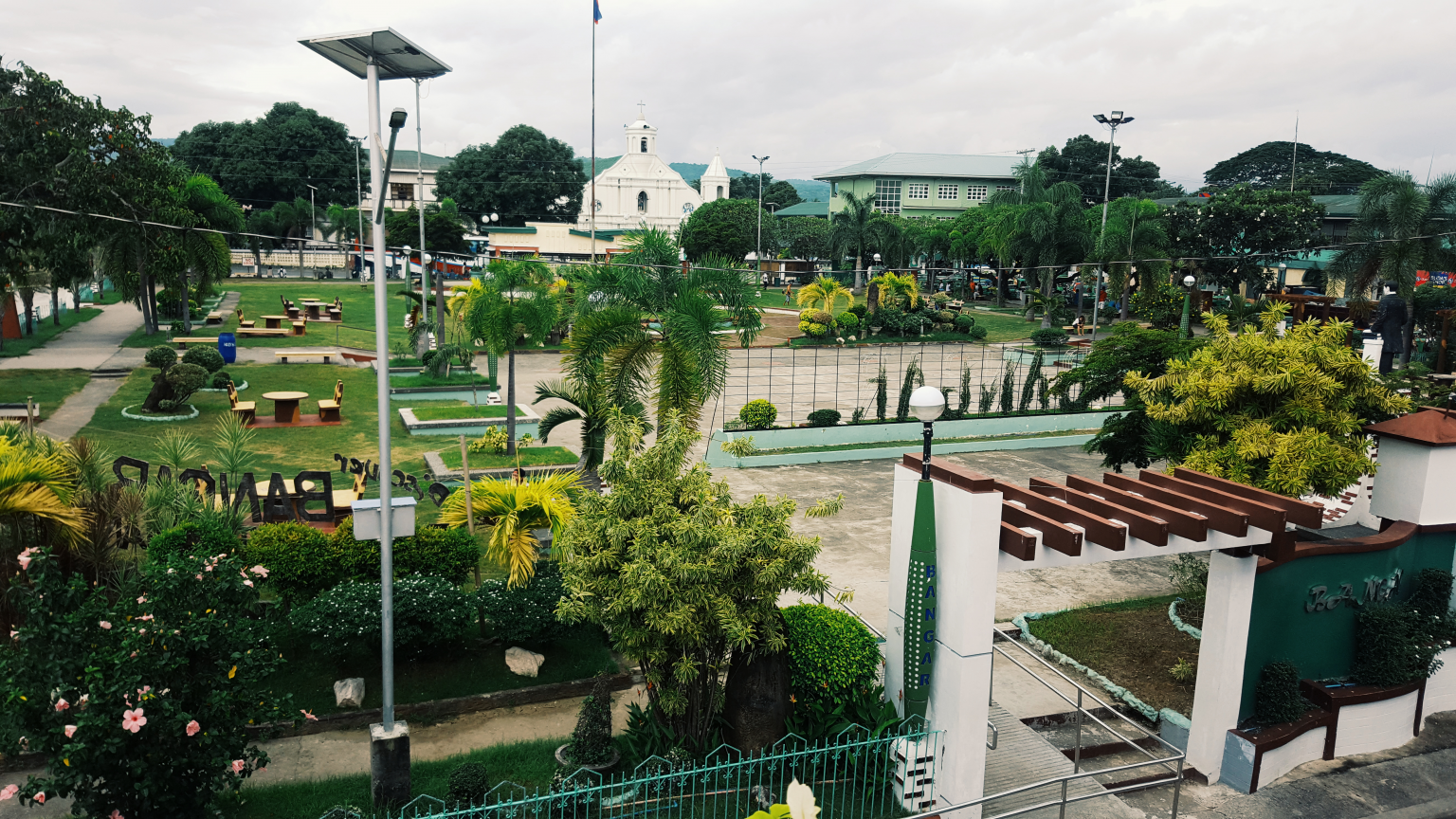
by: PRIMITIVO L. ACOSTA
BANGAR, with an area of approximately 4,379 hectares of land lies on the northern tip of La Union. It is bounded by the China Sea on the western side. Tagudin, Ilocos Sur on the north, Sudipen on the East and Balaoan and Luna on the south western side. At present it has a population of more than 29, 400 inhabitants. The fabled Amburayan River flows along the birder separating Bangar from Tagudin, Ilocos Sur.
1700 marked the official foundation of Bangar under the patronage of Saint Christopher when it became a ministry. However, Christianity when it became a ministry. However, Christianity was brought as early as the later part of 1500 when Bangar was still a visita of Tagudin. A book Historia Agustiniana, Authored by Fr. Isacio R. Rodriguez stated that the massive church was started in the year 1696 and was finished in 1967 by Fr. Francisco Alvear, a learned Spanish Agustinian priest born Liaño Sabrabder, Spain who died in BANGAR in 1698.
The Spanish convernt which still stands up to the present was built by Fr. Francisco Guadalupe sometime between 1866-1887. Likewise, the old municipal hall (it was burned during the Japanese time), the cemetery and the two schools (one was demolished and the other is now occupied by the Bangar Weaver’s Coop.) were constructed by the Agustinian priests, Fr. Benito Tesauro, OSA, was credited with the opening if the irrigation in Bangar which drew its water from the Amburayan
river. The road linking Bangar to Pura (Balaoan) was also his work.
When Bangar was still a visita to Tagudin, Ilocoa Sur, a community of 2,800 inhabitants was already in existence. The highly skilled, industrious and peace-loving people were primarily engaged in rice and cotton planting. The beautiful and sturdy handwoven products made by the ladies of that time even found their way to Europe and it was said that some of these materials were used as boat sails by the European sailors. Among the more famous handwoven products made by then were blankets bearing different designs clothing materials and mosquito nets. Since chemicals for coloring very scarce those days, bark of trees and fruits were used to dye all those handwoven products.
The town Bangar got its name from the bangar tree which was growing abundantly in the place where the town now stands. The bangar tree which is more known because of the foul odor that emanates from its fruits had other valuable usages, however, plants made from the dried tree were prized boars for the interior of houses. The fruits were soaked in oil and used as deep red dye for the handwoven products. The “indios infieles” (this term was given to the people who were not yet Christianized) used the spacious shade of the tree in performing their superstitious cult.
The old town of Bangar was made of three “pueblicitos” (small towns) namely: Villa-Cruz, San Rafael and San Anastacio. Near these “pueblicitos” were small communities of “Igorotes infieles” who paid tribute to the Governor. On the northern side or the town flowed the Amburayan river which later on become the setting on the Ilocano epic “Biag-ni-Lam-ang” penned by the Prince of the Ilocano Poets Pedro Bucaneg. The river was also another source of income for the inhabitants because in it were gold dusts and granules which were penned and collected. On the eastern side, the hills and the mountains were forested with different kinds of timber trees. It was there where the people got timber for their houses. On the western side of the town flowed the Busilac river which was a favorite fishing ground for the resident. Farther, on the eastern side at a distance which was covered by ten hours of walkingwas the village of Panguatan and still farther away was Bacong. These two communities were inhabited by pagans.
Through the “Superior Decreto” – (executive decree) signed by Governo
r General Antonio Maria Blanco on March 2, 1850, the town Barangay was made a part of La Union, the newly created province. Before that Bangar, Purao (Balaoan) and Namacpacan (Luna) were part of Ilocos Sur.
Among the early parish priest who were assigned in Bangar were the following.
1696-1698 – Fr. Francisco de Alvear: OSC (order of St. Agustin)
1805-1809 – Fr. Manuel Miranda: OP (Order of Preachers of Popularly known as Dominicans)
1853-1864 – Fr. Benito Tesauro: OSA
1866-1887 – Fr. Evaristo Guadalupe: OSA
(No records in kept about the years without parish priests)
As the years passed by, the barrios were formed and the following data will tell us some of what was said about them.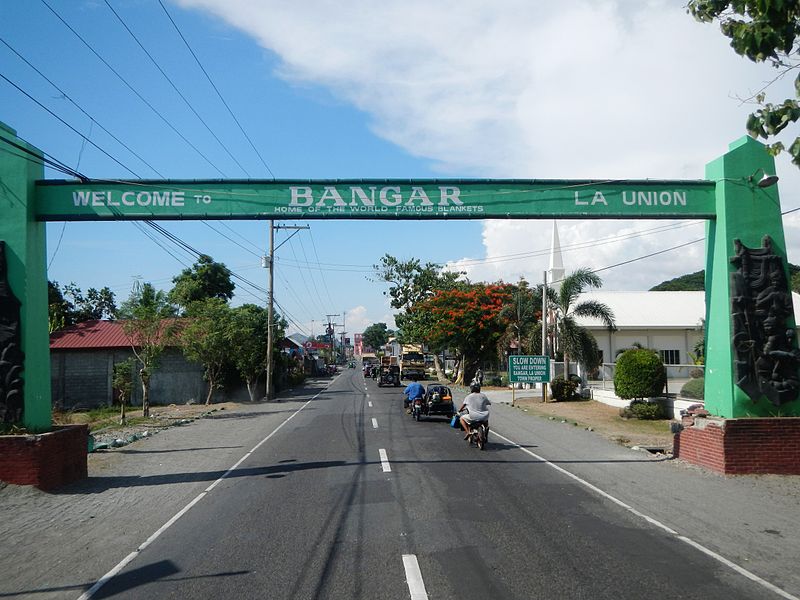
Agdeppa: A certain notorious man by the same name of Gabung was executed with outstretched arm. Since then, the place had been referred to as “Agdeppa” meaning outstretched arms.
Alzate: Named after the Spanish Officer Alzate who manned the garrison in that place against the “revelucianarios” (rebels). It is said that the Amburayan river which flowed to the part of Bangar was a favorite swimming spot for the Spaniard and the early “illustrados” (Educated residents of Bangar).
Bangaoilan: Anonang was the name. However, it was changed of Bangaoilan because of the abundance of a poisonous plants called “bangaoil”.
Barraca: This barrio was a merging of two sitios called Binyadura and Nagpalcan. Barraca was adopted as the common name after a pact has been signed by the residents who used to be very warlike.
Cadapli: This was taken frim the word “cadcapadapa” which means crawling and “apli” which means mat. This name was adopted after the capture of the robbers who hid in the forest near this barrio. They were captured sleeping in straw mats (apli) and severely whipped and punished until they were crawling (cadapa). Since then, the place was known as Cadapli.
Caggao: Named after a Pparasites called (cagaw) which infested the place.
Luzong: This place was formerly made if three sitios: Pideng, Butak and Dalimuno. Quicksand which caused the disappearance of working animals has been found in the lower places of these sitios. This place then was called Luzong which derived from the Ilocano word “lusong” which means “stuck”.
Maria Cristina: It is said that once an American asked for the name of the place from a beautiful girl. Thinking that the stranger was asking her name she answered “Maria Cristina”. Since then, the place was called Maria Cristina.
Mindoro: The name was derived from the Spanish term “Minas de Oro” which means “Gold Mine”. At that time, there gold dusts and granules in the river beside the barrio. People used to pan these and sold them to rich. Gen. Alzate who was manning the garrison there gave the name which later in become Mindoro.
Nagsabaran: This name was given to the place because the old National road branched out to that barrio. “Nagsabaran” means the place where the road branched out.
Paratong: The old name was Libtong which means, Lagoon. During the Spanish time the prefix Lib was changed into “para” which literally means “for”. This was added to “tong” hence the present name “Paratong”.
Quintarong: The old name of the place was “Daua ti Sabangan” (East of the mouth of the river). The place was reputed to the hideout of “tirong” (pirates) and the people of oftentimes saw these pirates running (Kinnamat) after one another. The present name now is “Quintarong”.
Reyna Regente: The place was named after a certain native queen name Regente who live before the arrival of the Spaniard. It is said that she was ruthless ruler but her youngest daughter who eventually took over her mother later in the ruled wisely.
Rissing: The old name “Pa-o” was taken after a big tree. How it become Rissing is now known.
San Blas: The place was named after a man who was reputedly known for his wisdom and who has San Blas for his namesake.
San Cristobal: Named after the town patron saint.
Sinapangan: Named after the Sapang tree which grew abundantly in the place.
Ubbog: The term “Ubbog” means spring. During the early days, water would surface even without a little digging on the ground.
Education during the Spanish time consisted of the learning of the “Cartilla” and the “abecedario” Roman Catholic Region was taught hand in hand with good manners. However, formal education belonged to the higher crust of society. Spanish social life had greatly affected the “idios” and in no time Castillan manners were very evident among them. The social cases of an individual was easily distinguished by the kind of attire one wore. The male peasant was distinguished by the simple “camisa de chino” (camisa chino) made of the fabric. He used pants cut along the western style. He wore socks and leather shoes and on the head was a hat which was usually plumed. A walking cane in various styles and colors and encased in silver, gold, or bronze was indispensable. He never smoked without using a pipe.
The upper class lady was very fastidious. She had her hair done in a brushed up coiffure. Curly hair was artificially effected by the use of stem of the papaya leaf iron rod which was heated over burning charcoal. However, so much care was given in using this method. Other women preferred to tie their hair in curls in the evening and untie these in the morning.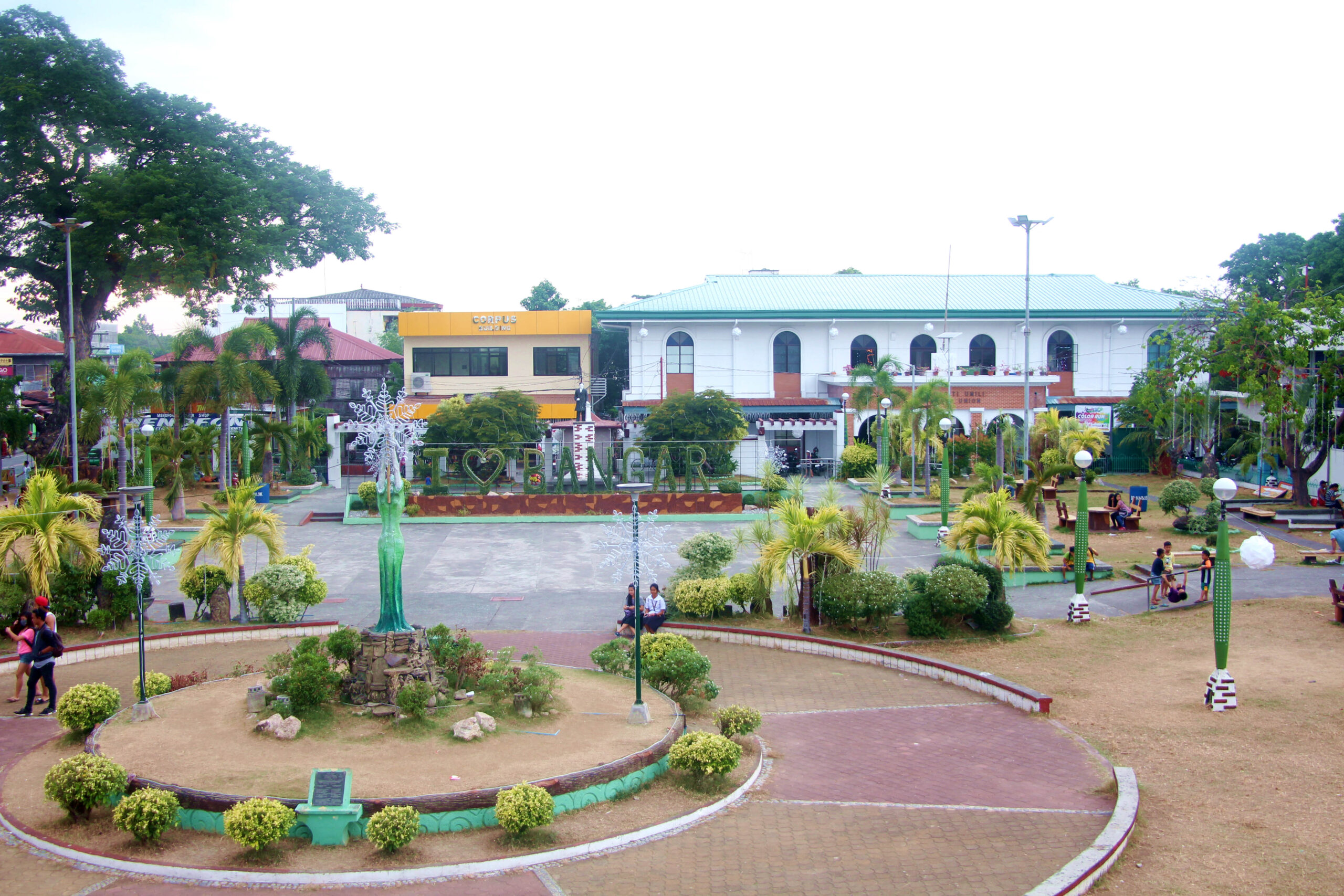
Ladies wore Maria Clara of the camisa which had embroidered and starched butterfly sleeves and matching panuelo. They used “alfiler” (pins) made of gold and silver. A comb called “peineta” usually fan shaped and encrusted on silver or gold adorned their hair. The skirt which was billowy was made from very fine fabric from China. Underneath she wore a long “camison” and over it was the “nuagas”. The outer Skirt was still topped by a beautiful imported lace. Perfumed fan and a big handkerchief timed with lace and handing on the right side of the skirt lucked to her waistline was a part of the attire. On Sundays and Holidays of obligation a “mantilla” made of lace which covered the head down to the waist and tucks to the hair by a gold pin was a must for the Holy Mass. On the feet the lady wore a “zapatilla” usually half heeled, adorned the artificial rhinestones. A gold pendant hanging from a gold necklace around the neck as also part of the attire. The “tambourine” a gold necklace with intricate designs was also worn on special days.
American type of education was felt with t he coming of the Americans in 1898. Education had a very high standard so that one who finish grade four could already teach those who were in the lower years.
The beginning of World War II was felt in Bangar on December 8, 1941, the feast of the Immaculate Conception. A lantern competition which was sponsored by rev. Jose P. Brillante, the parish priest was hastily cancelled and the church goers’ gas to hurry home after the offering of the Holy Mass and immediately prepared for the evacuation. Plans were constantly flying above and nearby hills carrying with them only those which were considered very important. Household furniture like tables, chairs, aparadors and even pianos had to be left behind. The people stayed in their evacuation places until they felt that it was safe for them to return to the town.
December 20, 1941 marked the entry of the Japanese Army to Bangar. They out up sentries along the national road and they had one at the Municipal Building and anther at the plaza. The Japanese occupation government required all citizens to display and pin a small Japanese.
Japanese flag outside the pocket of the shirt or blouse with the name of the holder written in Japanese. According to them, this was to distinguished peaceful citizens from guerilleros.
Upon the arrival of the Japanese forces all kinds of Philippine money disappeared from circulation. Immediately, the Japanese Government printed millions and millions of Japanese was noted so that even street urchins had money by the hundred in their pockets. Prices of commodities soared to a point where one peso could hardly buy anything Education, especially on the college kevel was stunted. English language as a subject had to be replaced by Nippongo (the Japanese language). There were not so many youngsters in Bangar who continued to study for fear of the Japanese.
Everything was not fearful though in a Japanese. There were many, especially among the educated ones who were very kind, friendly and understanding. They took time to teach youth athletics, ball games and good things about Japan.
During the early part of 1944, on a day Bangar was celebrating the birthday of Emperor Hirohito with a program at the town plaza, a truck load of Japanese soldiers arrived with a lone Filipino who was said to have been captured somewhere in Bacnotan. It was told that the Japanese took the Filipino behind the southern school building and ordered him to dig what was to be his own grave. Upon sensing that his hours on earth were counted, the Filipino suddenly grabbed and unheated the sword of the officer who was standing nearby and in one swift motion with the sword the officer almost got beheaded. This stunned the Japanese soldiers and the Filipino was able to escape unhurt. The whole town was gripped with terror. Japanese reprisal was foremost in the mind of the people. However, it was told that the ante mortem statement of the Japanese officer stated that the blamed should not be laid on the people of Bangar.
On December 28, 1944, the Japanese burned many houses, in the town proper and raided the camp of the guirrilleros in Barrio San Cristobal. It was believed that it was near Pudok.
There was not much social life during the Japanese regime. To break the monotony of the time, the youth of Bangar banded together and formed organizations. Among the most noteworthy organizations were the TTL (Tayo Tayo Lamang), an organization of the ladies and gentlemen of the town proper; te orchids, a group of teenagers which was put up exclusive for girls; a mized group of boys and girls in their early teens also put up their own group and they called it YGA (the Young Generation Association). This particular group took the risk of secretly passing food and cigarettes to the American and Filipino prisoners of was who made stop over in the town. 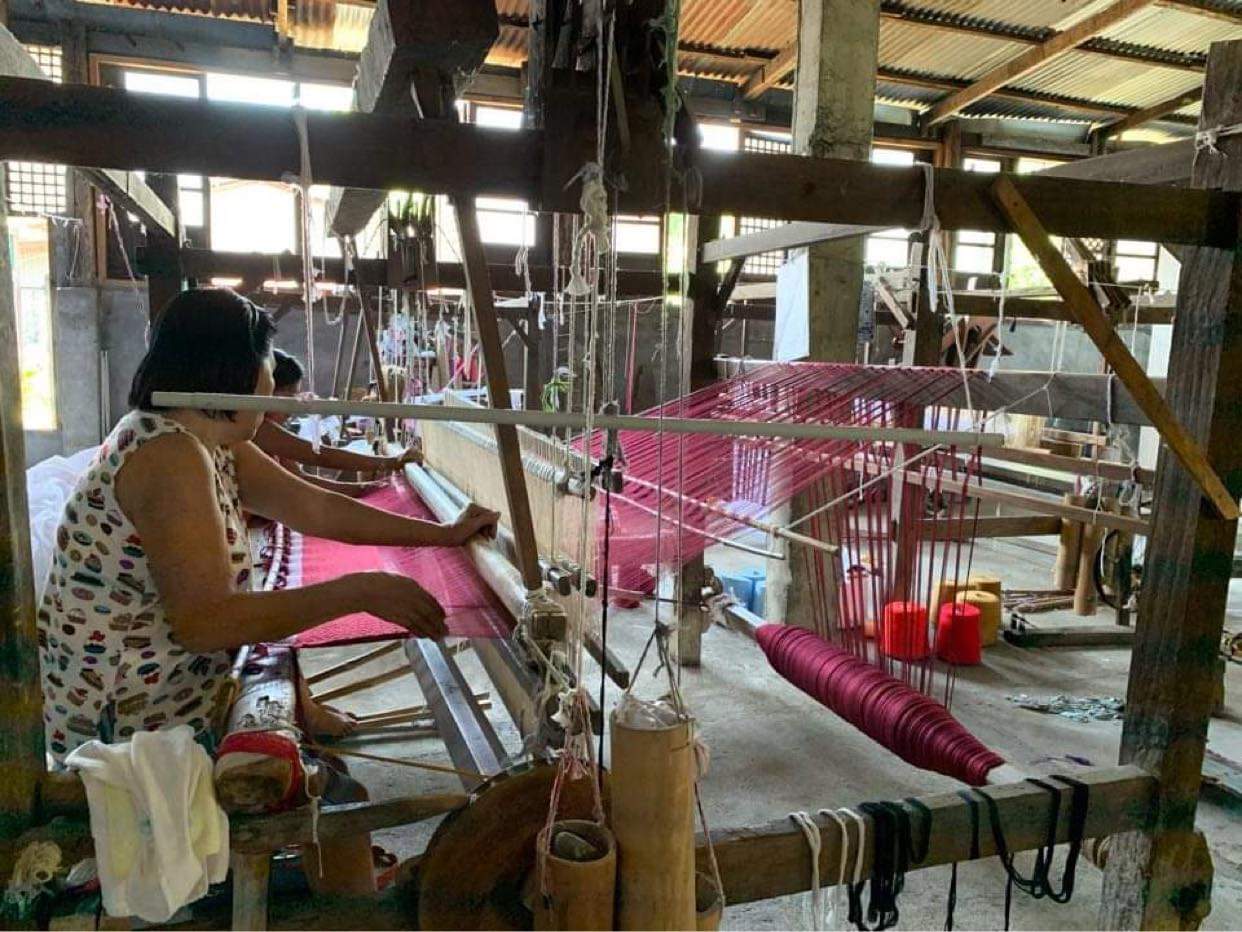 This groups too were responsible for enlivening the town fiesta by their collective cultural presentation.
This groups too were responsible for enlivening the town fiesta by their collective cultural presentation.
Underground movement was very strong in Bangar those days. Many residents joined the guerilla which had put up camps in San Cristobal. Further in the mountains at Lonoy, they also joined Camp “121”. Colonel Volkman and Major Agtarap led the guerilla movement. Arms which supplied to guerileros had put up camps in San Cristobal. Further in the mountains at Lonoy, they also joined Camp "121". Colonel Volkman and Major Agtarap led the guerilla movement. Arms which were supplied to guerileros were landed at Paraoir and bolo men had to carry these arms during night time.
The first Americans to reach Bangar during the liberation of the Philippines were certain Capt. Robertss and his men. They were met with lies and the surprise of their lives was the proficiency and fluency in the language of the people who met them.
Today, Bangar which is now a fifth class municipality has grown into a rich agricultural town. Its principal crop is rice while Virginia tobacco comes next however, farmers find planting corn, sugar cane, peanuts sweet potatoes, eggplants, string beans, ampalaya, squash and other vegetables quite lucrative and in between the rice and Virginia tobacco season farmers crop-rotate these vegetables. Only recently, cotton planting was reintroduced and the farmers are happy to note that the soil still good for the new found source of income.
Fishing occupies a greater time of the people from the coastal barangays of Bangar. “Ipon“ which comes out from the month of August to April is caught abundantly along the coastal barangays. Bangus fry is also caught from March to the earlier part of July. Tuna fish locally known as "oriles" and codfish abound in the coastal waters of Bangar. The Amburayan river also teems with "purong" during the early part of dry season.
Loom-weaving is the prime home industry of Bangar. The big of orders for placemats, towels, draperies, curtains and blankets from all over the Philippines and even abroad speaks well of the quality of the Bangar woven products.
Incidentally, Bangar loom-weaving was entered the livelihood Project Contest which was sponsored in the by the KKK. After winning the Provincial and Regional First Prizes, it went on to win first prize in the National Contest which was held at the University of Life on November 8, 1986. The feat meant a giant trophy and a fact cash prize of P7,000.00
Presently the basic needs of the townspeople are greatly attended to by the finished and on-going infrastructure projects of the local administration. Feeder roads are constructed everywhere and all barangays are now connected with one another by barangay roads. Almost three fourth of the entire open space of the public market is now cemented.
The people of Bangar are education and culture conscious. There are 16 complete primary elementary schools strategically found among the 33 barangays,
The four High Schools, CASACRISTO, an annex of the national high school, Dona Francisca Lacsamana De Ortega Memorial National High School (DFLOMNHS) National High School main campus, Regional Science High School (RSHS) and St. Christopher Academy, a diocesan school have combined population of 1,850 students. Among the culture conscious organization of Bangar, KAYAW CULTURAL SOCIETY founded in 1978 is proving to be the most active. The society which is made up of doctors, nurses, teachers, lawyers, municipal employees of other government agencies, PNP, tricycle drivers, students and out-of-school youth, present at least one big cultural vent every year. It sponsors foreign and local artists, too. Among the local and foreign big name presentations "Martir ti Golgotha", a Lenten drama based on the life of Jesus Christ and re-enacted by members of the KAYAW, "Jesus Christ Superstar", presented by Choral Society of Quezon City, the AVESOL of Riga Latvia USSRO and the Orfeon Universitario de la Universidad Central de Venezuela from Caracas, Venezuela, the UP Concert Chorus stand out to be the most impressive and most unforgettable. AVESOL, the premier chamber choir from Liga Latvia which presented RUSSIA in the first International Choral Festival in Manila last January 15, 1979 had a full house one night stand at the Theatre Court of St. Christopher Academy. In the same manner, Bangar will not forget the one night concert of the choir from Venezuela last January 22, 1981, and the UP Concert Chorus on March 17, 1984.
AVESOL, the premier chamber choir from Liga Latvia which presented RUSSIA in the first International Choral Festival in Manila last January 15, 1979 had a full house one night stand at the Theatre Court of St. Christopher Academy. In the same manner, Bangar will not forget the one night concert of the choir from Venezuela last January 22, 1981, and the UP Concert Chorus on March 17, 1984.
Civic and religious organizations in Bangar are not outdone in activity, The Blue Army and the Apostolada de la Oracion are among the most active. The members periodically conduct catechetical classes among children, help in validation, promote First Friday and First Saturday devotions and help the parishioners in many of their spiritual needs. The Knights of Columbus, too, are equally active.
A yearly affair, which involves all the barangays of Bangar is responsible in awakening the cultural values the people. For this cultural revival, each barangay of prepares a Filipino Chorus, native folk dances, a play let with Filipino moral values, a Bukanegan, a Daniw and a Duet. Every December 25" at seven o'clock in the evening, a Festival of Choral Songs with Choreography, Folk Dances, Dramas, Bukanegans, Duets and Daniws are presented by the finalists and the defending champions at the Imelda Cultural Stage. Ilocano Short Story Writing Contest has been added.
This cultural revival has started to bear fruits among the Youth of Bangar. The St. Christopher Academy Youth Choir romped away with the plum prize with its rendition of "Salidummay" during the Himig “82 Finals at the Cultural Center of the Philippines. The Dona Francisca Lacsamana de Ortega Memorial National High School Youth Choir likewise duplicated this fact by besting the regional Il choirs at the Folk Arts Theatre during the Himig '83 and Himig '84
The 1986 February revolution at EDSA has given Bangar a new officer-in-charge in the office in the person of Atty. Reynaldo M. Mosuela. However, all the good programs initiated by this predecessor, former Mayor Avelino M. Pascua were continued with the same vigor and other good endeavors were added to them.
December 1, 1987 saw a new set of Officer-in Charge which was led by the OIC, office of the Mayor in the person of Mr. Primitivo L. Acosta. The Officers-in-Charge replaced all the incumbent OIC's who opted to run a candidates for different positions in the 1987 elections. Their lenure of office although for a short time saw the increase of the per diems of the Barangay Captains and putting up of street signs in the different crossroads of the town. The people of Bangar put a new town executive in the person of Mr. George B. Pinzon, a school teacher by profession during the 1987 elections. He started good and although he is less than four years in the Local Government the town is feeling his able leadership especially in terms of peace and order. However, his one dream is the completion of the Amburayan River dike flood control
During his tenure as Chief Executives, the town felt his good leadership especially in terms of peace and order. He made good us of the R.A. 7171 by putting up many multi-purpose pavements, bridges and 90% of the existing barangay roads constructed under his initiative.  His dream of the completion of the Amburayan River Flood were Control and all the above mentioned endeavors were of seeing realized through the help of the President of the Philippines, His Excellency Fidel V. Ramos, the late Congressman Joaquin "Titing" Ort Ortega, Governor Justo Orros, and past Congressman Victor Ortega
His dream of the completion of the Amburayan River Flood were Control and all the above mentioned endeavors were of seeing realized through the help of the President of the Philippines, His Excellency Fidel V. Ramos, the late Congressman Joaquin "Titing" Ort Ortega, Governor Justo Orros, and past Congressman Victor Ortega
1998 saw the emergence of a new Mayor in in the person of Hon. Gary N. Pinzon, the eldest son of outgoing Mayor. He started good and with the help of the Almighty God, he will help Bangar with the same. Initiative and I diligence like this his father. The scenic spots in Bangar constantly lure local and international loves of nature and weekend excurtionists. An afternoon stroll along the Amburayan River dike will give one breathtaking view of the Ilocos. Coast range and constantly remind him of the exploits of the legendary "Lam-ang". The sunset in Bangar is an unending attraction of the late strollers and art conscious "aficionados". A sit on one of the benches of the beautiful park would afford one quiet meditation by listening to the installed piped-in music and by looking at the awe-in-spring tree towered centuries old Roman Catholic Church. Looking westward. One could not but feel nostalgia for the bygone days of the Spanish era by looking at the imposing Rizal monuments and the reconstructed Municipal building. Just a few steps north of the plaza is the beautiful gift of the former President of the Philippines, His Excellency Ferdinand E. Marcos through sponsorship of the former Minister of Tourism, Hon. Jose D. Aspiras, a big stage constructed by Gen. Manager Engr. Bernardo Vergara of the Philippine Tourism Authority. This is a gift to the art-loving people of Bangar. Evening always see the park filled with playing children lovers exchanging sweet nothings, elderly folks discussing family problems and people who would like to talk the latest gossip
The crime rate in Bangar is almost nil. The constantly empty jails is an eloquent proof of the peace that pervades the town. Thanks to the peace-loving people of Bangar with Mayor Joy Pinzon Merin at the helm.
